Overview
- Brief Narrative
- Triple leather ammunition pouch for the Mauser K98k (Karabiner Kurz) rifle acquired ca. 2005 by Yahad-In Unum while excavating mass execution and grave sites in Ukraine uncovered by their research into atrocities committed by Nazi Germany against the Jewish population during WWII. It was the standard issue rifle ammunition pouch for the German Army during World War II. Each pouch holds thirty rounds of ammunition and would be looped through a soldier's belt. In September 1939, following Germany's invasion of Poland, areas of eastern Poland, presently the Ukraine, were occupied by the Soviet Union pursuant to the terms of the German-Soviet Pact. In late June 1941, Germany launched Operation Barbarossa, a surprise attack on Russia. The military assault was coordinated with killing squads whose goal was the Final Solution, the elimination of all Jews from the conquered territories. With the assistance of trained collaborators and the local populace, the goal was achieved through deportations to killing centers and mass executions throughout the region. The lack of adequate rail transport meant that many villages had killing fields where the Jews were shot and buried in huge ditches, along with the bullets and other evidence. Through interviews with the remaining eyewitnesses, Yahad-In Unum locates and documents these remains of a Holocaust by bullets and offers respectful remembrance for the fallen.
- Date
-
found:
2005
manufacture: 1938
- Geography
-
received:
Ukraine
- Credit Line
- United States Holocaust Memorial Museum Collection, Gift of Yahad-in Unum
- Markings
- middle pouch, interior of lid, black ink : L . B . A . (S) 39
- Contributor
-
Subject:
Patrick Desbois
Subject: Yahad-In Unum
- Biography
-
Father Patrick Desbois is the president of Yahad- In Unum (Together as One), an organization he co-founded in 2004 to develop and promote Christian-Jewish understanding. He is also a Roman Catholic priest and director of the Episcopal Committee for Relations with Judaism, which is connected with the French Conference of Bishops.
Father Desbois was born in Chalon-sur-Saone, France, in 1955 and grew up on a farm in the Bresse region of eastern France. As a young man, he joined the French civil service and taught mathematics in West Africa. He went to Calcutta to work with Mother Teresa for three months. After this, he decided to join the priesthood, a decision that shocked his secular family. He became a parish priest and studied Judaism and learned Hebrew. He asked to do outreach work with groups such as Roma, ex-prisoners, and Jews, and was appointed a liaison with the Jewish community in France.
His family had lived on the farm throughout the German occupation of France during World War II, 6/25/1940-8/25/1944. His paternal grandfather, as a soldier in the French Army, had been deported by the Germans following the occupation. He was sent to Rava-Ruska prison camp, then on the Ukrainian side of the Polish border, now in Ukraine. His grandfather never talked about his experiences, but he did once comment to his grandson that, as bad as it was for French prisoners-of-war, it was much worse for other types of inmates. A maternal cousin who had been a member of the resistance was deported and killed in a German concentration camp. As an adult, he learned from his mother that the family had often hidden members of the French Resistance on the farm.
Desbois was haunted by his grandfather's silence. He made repeated trips to Rava-Ruska where his grandfather had been imprisoned. On one visit, the mayor took him to the edge of the forest where a group of elderly villagers were gathered to tell him what they had witnessed. Desbois finally learned what his grandfather would not say - that, unlike what Desbois had supposed, the killings were not done in secret. They were public spectacles, performed in broad daylight, and people wanted to be there and watch. Since 2001, Desbois has led research teams to discover the fate of Jewish victims of Nazi Germany, specifically of the Einsatzgruppen [killing squads] that operated in Eastern Europe during World War II. Based in Paris, Yahad-in Unum’s mission is to discover every mass grave and site where Jews were killed in the Ukraine. They research and compare documents from German and Soviet archives, searching for clues to locations where the killings occurred. They then travel to the villages to find witnesses who will tell them the location of the mass graves. Yahad has identified over 800 of an estimated 2000 sites. Father Desbois also seeks out and has recorded personal testimonies of hundreds of the remaining witnesses to the atrocities. As of 2015, they had recorded 4000 witness testimonies. “At first, sometimes, people don’t believe I’m a priest. I have to use simple words and listen to these horrors - without any judgment. I cannot react to the horrors that pour out. If I react, the stories will stop.”
Yahad–In Unum was created in 2004 to facilitate understanding and collaboration between Catholics and Jews. The name of the organization is based upon the Hebrew and Latin words for together. The central reseach mission is to document the mass executions of more than 2 million Jews and thousands of Roma people in Eastern Europe between 1941 and 1944 by Nazi Germany and those who collaborated with them. Through the investigation of this Holocaust by bullets, Yahad-In Unum has discovered hundreds of mass graves of murdered victims and recorded the testimony of more than 3000 witnesses. The organization works to collect the evidence, village by village, region by region, searching for the last witnesses to these crimes. Yahad-In Unum seeks to identify each grave site in order to refute those who deny the Holocaust and to allow for the respectful remembrance of the fallen.
Physical Details
- Classification
-
Containers
- Category
-
Ammunition containers
- Object Type
-
Cartridge belts (lcsh)
- Physical Description
- Wide, brown pebbled leather belt attachment with 3 ammunition pouches, each with a rectangular base and cap lid with a sewn-on strap that latches over a metal stud on the underside. On the interior middle pouch lid are letter acronyms and numbers; riveted on the reverse is a rectangular leather placket with a metal D ring inserted through a top loop, an illegible maker code, and the date 1938. Riveted on the reverse of the other 2 pouches is a strap that latches over the bottom stud and passes underneath a horizontal strap riveted near the bottom.
- Dimensions
- overall: Height: 4.750 inches (12.065 cm) | Width: 8.375 inches (21.273 cm) | Depth: 1.500 inches (3.81 cm)
- Materials
- overall : leather, metal, ink
- Inscription
- middle pouch, reverse, center, incised : illegible text / 1938 / 1938
Rights & Restrictions
- Conditions on Access
- No restrictions on access
- Conditions on Use
- No restrictions on use
Keywords & Subjects
Administrative Notes
- Legal Status
- Permanent Collection
- Provenance
- The cartridge belt was donated to the United States Holocaust Memorial Museum in 2010 by Yahad-in-Unum.
- Funding Note
- The cataloging of this artifact has been supported by a grant from the Conference on Jewish Material Claims Against Germany.
- Record last modified:
- 2022-07-28 21:51:10
- This page:
- https://collections.ushmm.org/search/catalog/irn43051
Download & Licensing
In-Person Research
- By Appointment
- Request 21 Days in Advance of Visit
- Plan a Research Visit
- Request to See This Object
Contact Us
Also in The Yahad-In Unum Collection at the United States Holocaust Memorial Museum
The collection consists of artifacts used or discovered by Yahad-in Unum during their work to investigate and to document the mass executions of more than 2 million Jews in Eastern Europe between 1941 and 1944 by Nazi Germany and those who collaborated with therm.
Date: 1941-approximately 1943
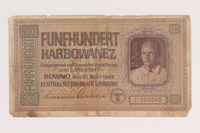
Occupation currency note, 500 Karbowanez, issued by Nazi Germany in eastern Poland
Object
German occupation currency note, valued at 500 Karbowanez, issued in Rovno, Poland (Rivne, Ukraine) in March 1942. In September 1939, not long after the invasion of Poland by Nazi Germany, Rovno was occupied by the Soviet Union under the terms of the German-Soviet Pact. Rovno was occupied by the Soviet Union per the terms of the Nazi-Soviet Pact. On June 22, 1941, Germany launched a surprise attack, Operation Barbarossa, on Russia. A week later, German troops occupied Rovno. The city was liberated by the Soviet Army on February 2, 1944. The currency was recovered by Yahad-In Unum as they researched the atrocities committed by Nazi Germany against the Jewish population in Eastern Europe. The organization has located hundreds of mass execution and grave sites to document this Holocaust by bullets and to allow for the respectful remembrance of the fallen.
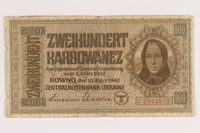
Occupation currency note, 200 Karbowanez, issued by Nazi Germany in eastern Poland
Object
German occupation currency note, valued at 200 Karbowanez, issued in Rovno, Poland (Rivne, Ukraine) in March 1942. In September 1939, not long after the invasion of Poland by Nazi Germany, Rovno was occupied by the Soviet Union under the terms of the German-Soviet Pact. On June 22, 1941, Germany launched a surprise attack, Operation Barbarossa, on Russia. A week later, German troops occupied Rovno. The city was liberated by the Soviet Army on February 2, 1944. The currency was recovered by Yahad-In Unum as they researched the atrocities committed by Nazi Germany against the Jewish population in Eastern Europe. The organization has located hundreds of mass execution and grave sites to document this Holocaust by bullets and to allow for the respectful remembrance of the fallen.
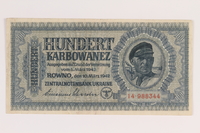
Occupation currency note, 100 Karbowanez, issued by Nazi Germany in eastern Poland
Object
German occupation currency note, valued at 100 Karbowanez, issued in Rovno, Poland (Rivne, Ukraine) in March 1942. In September 1939, not long after the invasion of Poland by Nazi Germany, Rovno was occupied by the Soviet Union under the terms of the German-Soviet Pact. On June 22, 1941, Germany launched a surprise attack, Operation Barbarossa, on Russia. A week later, German troops occupied Rovno. The city was liberated by the Soviet Army on February 2, 1944. The currency was recovered by Yahad-In Unum as they researched the atrocities committed by Nazi Germany against the Jewish population in Eastern Europe. The organization has located hundreds of mass execution and grave sites to document this Holocaust by bullets and to allow for the respectful remembrance of the fallen.

Occupation currency note, 50 Karbowanez, issued by Nazi Germany in eastern Poland
Object
German occupation currency note, valued at 50 Karbowanez, issued in Rovno, Poland (Rivne, Ukraine) in March 1942. In September 1939, not long after the invasion of Poland by Nazi Germany, Rovno was occupied by the Soviet Union under the terms of the German-Soviet Pact. On June 22, 1941, Germany launched a surprise attack, Operation Barbarossa, on Russia. A week later, German troops occupied Rovno. The city was liberated by the Soviet Army on February 2, 1944. The currency was recovered by Yahad-In Unum as they researched the atrocities committed by Nazi Germany against the Jewish population in Eastern Europe. The organization has located hundreds of mass execution and grave sites to document this Holocaust by bullets and to allow for the respectful remembrance of the fallen.

Occupation currency note, 10 Karbowanez, issued by Nazi Germany in eastern Poland
Object
German occupation currency note, valued at 10 Karbowanez, issued in Rovno, Poland (Rivne, Ukraine) in March 1942. In September 1939, not long after the invasion of Poland by Nazi Germany, Rovno was occupied by the Soviet Union under the terms of the German-Soviet Pact. On June 22, 1941, Germany launched a surprise attack, Operation Barbarossa, on Russia. A week later, German troops occupied Rovno. The city was liberated by the Soviet Army on February 2, 1944. The currency was recovered by Yahad-In Unum as they researched the atrocities committed by Nazi Germany against the Jewish population in Eastern Europe. The organization has located hundreds of mass execution and grave sites to document this Holocaust by bullets and to allow for the respectful remembrance of the fallen.

Occupation currency note, 5 Karbowanez, issued by Nazi Germany in eastern Poland
Object
German occupation currency note, valued at 5 Karbowanez, issued in Rovno, Poland (Rivne, Ukraine) in March 1942. In September 1939, not long after the invasion of Poland by Nazi Germany, Rovno was occupied by the Soviet Union under the terms of the German-Soviet Pact. On June 22, 1941, Germany launched a surprise attack, Operation Barbarossa, on Russia. A week later, German troops occupied Rovno. The city was liberated by the Soviet Army on February 2, 1944. The currency was recovered by Yahad-In Unum as they researched the atrocities committed by Nazi Germany against the Jewish population in Eastern Europe. The organization has located hundreds of mass execution and grave sites to document this Holocaust by bullets and to allow for the respectful remembrance of the fallen.

Occupation credit treasury note, 50 Reichspfennig, issued by Nazi Germany
Object
German occupation credit treasury note, valued at 50 Reichspfennig, issued in Berlin, Germany by the Reichskreditkassen (Reich Credit Treasury Bank) for use in German occupied countries. In an effort to strengthen the economies of German occupied countries, credit treasury notes could only be used in the specific occupied country alongside the local currency. Soldiers in the German army also received their pay in credit treasury notes. The currency was recovered by Yahad-In Unum as they researched the atrocities committed by Nazi Germany against the Jewish population in Eastern Europe. The organization has located hundreds of mass execution and grave sites to document this Holocaust by bullets and to allow for the respectful remembrance of the fallen.
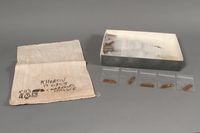
112 discharged German manufactured stripper clips found at a mass execution site
Object
112 discharged stripper clips, with the contemporary archeological bag used for transport, recovered in 2005 by Yahad-In Unum at a mass execution site in Khvativ, a small village in the Lvivska province of Ukraine. Stripper clips contain five to ten cartridges and accelerate the loading process of an infantry or semi-automatic rifle. Two clips in this selection have a code identifying the German manufacturer. In September 1939, not long after the invasion of Poland by Nazi Germany, the Lvivska province was occupied by the Soviet Union under the terms of the German-Soviet Pact. In late June 1941, Germany launched Operation Barbarossa, a surprise attack on Russia. The military assault was coordinated with killing squads whose goal was the Final Solution, the elimination of all Jews from the conquered territories. With the assistance of trained collaborators and local populace, the goal was achieved through deportations to killing centers and mass executions throughout the region. The lack of adequate rail transport meant that many villages had killing fields where the Jews were shot and buried in huge ditches, along with the bullets and other evidence. Through interviews with the remaining eyewitnesses, Yahad-In Unum locates and documents these remains of a Holocaust by bullets and offers respectful remembrance for the fallen.

337 discharged German and Polish manufactured bullet casings found at a mass execution site
Object
337 discharged bullet casings, and a contemporary archeological bag used to transport them, recovered in 2005 by Yahad-In Unum at a mass execution site in Khvativ, a small village in the Lvivska province of Ukraine. A casing contains propellant and primer, and holds the bullet in place. Several of the casings have a headstamp marking the German and Polish manufacturer, location, year, batch, and material. In September 1939, following Germany's invasion of Poland, the Lvivska province was occupied by the Soviet Union pursuant to the terms of the German-Soviet Pact. In late June 1941, Germany launched Operation Barbarossa, a surprise attack on Russia. The military assault was coordinated with killing squads whose goal was the Final Solution, the elimination of all Jews from the conquered territories. With the assistance of trained collaborators and the local populace, the goal was achieved through deportations to killing centers and mass executions throughout the region. The lack of adequate rail transport meant that many villages had killing fields where the Jews were shot and buried in huge ditches, along with the bullets and other evidence. Through interviews with the remaining eyewitnesses, Yahad-In Unum locates and documents these remains of a Holocaust by bullets and offers respectful remembrance for the fallen.
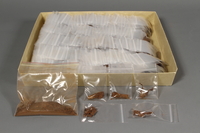
310 discharged German manufactured bullet casings found at a mass execution site
Object
310 discharged bullet casings, with the contemporary archeological bag used to transport them, recovered in 2005 by Yahad-In Unum at a mass execution site in Khvativ, a small village in the Lvivska province of Ukraine. A casing contains propellant and primer, and holds the bullet in place. Several casings have a headstamp marking the German manufacturer, location, year, batch, and material. In September 1939, following Germany's invasion of Poland, the Lvivska province was occupied by the Soviet Union pursuant to the terms of the German-Soviet Pact. In late June 1941, Germany launched Operation Barbarossa, a surprise attack on Russia. The military assault was coordinated with killing squads whose goal was the Final Solution, the elimination of all Jews from the conquered territories. With the assistance of trained collaborators and the local populace, the goal was achieved through deportations to killing centers and mass executions throughout the region. The lack of adequate rail transport meant that many villages had killing fields where the Jews were shot and buried in huge ditches, along with the bullets and other evidence. Through interviews with the remaining eyewitnesses, Yahad-In Unum locates and documents these remains of a Holocaust by bullets and offers respectful remembrance for the fallen.

500 discharged German manufactured bullet casings found at a mass execution site
Object
500 discharged bullet casings, with the contemporary archeological bag used for transport, recovered in 2005 by Yahad-In Unum at a mass execution site in Khvativ, a small village in the Lvivska province of Ukraine. A casing contains propellant and primer, and holds the bullet in place. Several casings have a headstamp marking the German manufacturer, location, year, batch, and material. In September 1939, following Germany's invasion of Poland, the Lvivska province was occupied by the Soviet Union pursuant to the terms of the German-Soviet Pact. In late June 1941, Germany launched Operation Barbarossa, a surprise attack on Russia. The military assault was coordinated with killing squads whose goal was the Final Solution, the elimination of all Jews from the conquered territories. With the assistance of trained collaborators and the local populace, the goal was achieved through deportations to killing centers and mass executions throughout the region. The lack of adequate rail transport meant that many villages had killing fields where the Jews were shot and buried in huge ditches, along with the bullets and other evidence. Through interviews with the remaining eyewitnesses, Yahad-In Unum locates and documents these remains of a Holocaust by bullets and offers respectful remembrance for the fallen.

75 discharged bullet casings and 2 machine gun link ammunition belt sections found at a mass execution site
Object
75 discharged bullet casings and 2 non-disintegrating machine gun link ammunition belt pieces for MG 34 and 42 German machine guns, with the contemporary archeological bag used for transport, recovered in 2005 by Yahad-In Unum at a mass execution site in Khvativ, a small village in the Lvivska province of Ukraine. A casing contains propellant and primer, and holds the bullet in place. An ammunition belt is used to load cartridges into an automatic weapon. One casing has a headstamp marking the German manufacturer, location, year, batch, and material. In September 1939, following Germany's invasion of Poland, the Lvivska province was occupied by the Soviet Union pursuant to the terms of the German-Soviet Pact. In late June 1941, Germany launched Operation Barbarossa, a surprise attack on Russia. The military assault was coordinated with killing squads whose goal was the Final Solution, the elimination of all Jews from the conquered territories. With the assistance of trained collaborators and the local populace, the goal was achieved through deportations to killing centers and mass executions throughout the region. The lack of adequate rail transport meant that many villages had killing fields where the Jews were shot and buried in huge ditches, along with the bullets and other evidence. Through interviews with the remaining eyewitnesses, Yahad-In Unum locates and documents these remains of a Holocaust by bullets and offers respectful remembrance for the fallen.

300 discharged German manufactured bullet casings found near a mass execution site
Object
300 discharged bullet casings, with the contemporary archeological bag they were transported in, recovered in 2005 by Yahad-In Unum at a mass execution site in Khvativ, a small village in the Lvivska province of Ukraine. A casing contains propellant and primer, and holds the bullet in place. Several of the casings have a headstamp marking the German manufacturer, location, year, batch, and material. In September 1939, following Germany's invasion of Poland, the Lvivska province was occupied by the Soviet Union pursuant to the terms of the German-Soviet Pact. In late June 1941, Germany launched Operation Barbarossa, a surprise attack on Russia. The military assault was coordinated with killing squads whose goal was the Final Solution, the elimination of all Jews from the conquered territories. With the assistance of trained collaborators and the local populace, the goal was achieved through deportations to killing centers and mass executions throughout the region. The lack of adequate rail transport meant that many villages had killing fields where the Jews were shot and buried in huge ditches, along with the bullets and other evidence. Through interviews with the remaining eyewitnesses, Yahad-In Unum locates and documents these remains of a Holocaust by bullets and offers respectful remembrance for the fallen.
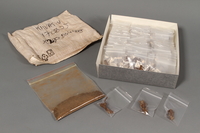
240 discharged German manufactured bullet casings found near a mass execution site
Object
240 discharged bullet casings, with the contemporary archeological bag they were transported in, recovered in 2005 by Yahad-In Unum at a mass execution site in Khvativ, a small village in the Lvivska province of Ukraine. A casing contains propellant and primer, and holds the bullet in place. Several of the casings have a headstamp marking the German manufacturer, location, year, batch, and material. In September 1939, following Germany's invasion of Poland, the Lvivska province was occupied by the Soviet Union pursuant to the terms of the German-Soviet Pact. In late June 1941, Germany launched Operation Barbarossa, a surprise attack on Russia. The military assault was coordinated with killing squads whose goal was the Final Solution, the elimination of all Jews from the conquered territories. With the assistance of trained collaborators and the local populace, the goal was achieved through deportations to killing centers and mass executions throughout the region. The lack of adequate rail transport meant that many villages had killing fields where the Jews were shot and buried in huge ditches, along with the bullets and other evidence. Through interviews with the remaining eyewitnesses, Yahad-In Unum locates and documents these remains of a Holocaust by bullets and offers respectful remembrance for the fallen.

143 discharged machine gun link ammunition belt sections found at a mass execution site in Ukraine
Object
143 discharged non-disintegrating link ammunition belt pieces for MG 34 and 42 German machine guns, with the contemporary archeological bag they were transported in, recovered in 2005 by Yahad-In Unum at a mass execution site in Khvativ, a small village in the Lvivska province of Ukraine. An ammunition belt is used to load cartridges into an automatic weapon. In September 1939, following Germany's invasion of Poland, the Lvivska province was occupied by the Soviet Union pursuant to the terms of the German-Soviet Pact. In late June 1941, Germany launched Operation Barbarossa, a surprise attack on Russia. The military assault was coordinated with killing squads whose goal was the Final Solution, the elimination of all Jews from the conquered territories. With the assistance of trained collaborators and the local populace, the goal was achieved through deportations to killing centers and mass executions throughout the region. The lack of adequate rail transport meant that many villages had killing fields where the Jews were shot and buried in huge ditches, along with the bullets and other evidence. Through interviews with the remaining eyewitnesses, Yahad-In Unum locates and documents these remains of a Holocaust by bullets and offers respectful remembrance for the fallen.

157 discharged machine gun link ammunition belt sections found at a mass execution site
Object
157 discharged non-disintegrating link ammunition belt pieces for MG 34 and 42 German machine guns, with the contemporary archeological bag that they were transported in, recovered in 2005 by Yahad-In Unum at a mass execution site in Khvativ, a small village in the Lvivska province of Ukraine. An ammunition belt is used to load cartridges into an automatic weapon. In September 1939, following Germany's invasion of Poland, the Lvivska province was occupied by the Soviet Union pursuant to the terms of the German-Soviet Pact. In late June 1941, Germany launched Operation Barbarossa, a surprise attack on Russia. The military assault was coordinated with killing squads whose goal was the Final Solution, the elimination of all Jews from the conquered territories. With the assistance of trained collaborators and the local populace, the goal was achieved through deportations to killing centers and mass executions throughout the region. The lack of adequate rail transport meant that many villages had killing fields where the Jews were shot and buried in huge ditches, along with the bullets and other evidence. Through interviews with the remaining eyewitnesses, Yahad-In Unum locates and documents these remains of a Holocaust by bullets and offers respectful remembrance for the fallen.

Contemporary archeological bag with French text used during excavation of a mass execution site
Object
Contemporary archeological bag used to transport a shovel found in 2005 by Yahad-In Unum in Khvativ, a small village in the Lvivska province of Ukraine, while excavating mass execution and grave sites uncovered by their research into the atrocities committed by Nazi Germany against the Jewish population. In September 1939, following Germany's invasion of Poland, areas of eastern Poland, now in Ukraine, were occupied by the Soviet Union pursuant to the terms of the German-Soviet Pact. In late June 1941, Germany launched Operation Barbarossa, a surprise attack on Russia. The military assault was coordinated with killing squads whose goal was the Final Solution, the elimination of all Jews from the conquered territories. With the assistance of trained collaborators and the local populace, the goal was achieved through deportations to killing centers and mass executions throughout the region. The lack of adequate rail transport meant that many villages had killing fields where the Jews were shot and buried in huge ditches, along with the bullets and other evidence. Through interviews with the remaining eyewitnesses, Yahad-In Unum locates and documents these remains of a Holocaust by bullets and offers respectful remembrance for the fallen.
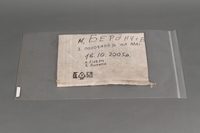
Contemporary archeological bag with Ukrainian text used during excavation of a mass execution site
Object
Contemporary archeological bag used to transport shells and a shovel found in 2005 by Yahad-In Unum in Berdychiv, Ukraine, during the excavation of mass execution and grave sites uncovered by their research into the atrocities committed by Nazi Germany against the Jewish population. In September 1939, following Germany's invasion of Poland, areas of eastern Poland, now in Ukraine, were occupied by the Soviet Union pursuant to the terms of the German-Soviet Pact. In late June 1941, Germany launched Operation Barbarossa, a surprise attack on Russia. The military assault was coordinated with killing squads whose goal was the Final Solution, the elimination of all Jews from the conquered territories. With the assistance of trained collaborators and the local populace, the goal was achieved through deportations to killing centers and mass executions throughout the region. The lack of adequate rail transport meant that many villages had killing fields where the Jews were shot and buried in huge ditches, along with the bullets and other evidence. Through interviews with the remaining eyewitnesses, Yahad-In Unum locates and documents these remains of a Holocaust by bullets and offers respectful remembrance for the fallen.

10 bullet casings recovered during excavation of a mass execution site
Object
10 discharged bullet casings, one of French manufacture, found ca. 2005 by Yahad-In Unum while excavating mass execution and grave sites in Ukraine uncovered by their research into the atrocities committed by Nazi Germany against the Jewish population. A casing contains propellant and primer, and holds the bullet in place. One casing has a headstamp marking the French manufacturer and date. In September 1939, following Germany's invasion of Poland, areas of eastern Poland, now in Ukraine, were occupied by the Soviet Union pursuant to the terms of the German-Soviet Pact. In late June 1941, Germany launched Operation Barbarossa, a surprise attack on Russia. The military assault was coordinated with killing squads whose goal was the Final Solution, the elimination of all Jews from the conquered territories. With the assistance of trained collaborators and the local populace, the goal was achieved through deportations to killing centers and mass executions throughout the region. The lack of adequate rail transport meant that many villages had killing fields where the Jews were shot and buried in huge ditches, along with the bullets and other evidence. Through interviews with the remaining eyewitnesses, Yahad-In Unum locates and documents these remains of a Holocaust by bullets and offers respectful remembrance for the fallen.
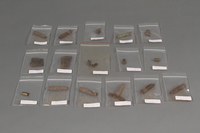
3 9mm Luger bullet casings recovered during the excavations of mass execution sites
Object
3 discharged 9mm Luger Czechoslovakian manufactured bullet casings acquired ca. 2005 by Yahad-In Unum while excavating mass execution and grave sites in Ukraine uncovered by their research into the atrocities committed by Nazi Germany against the Jewish population. A casing contains propellant and primer, and holds the bullet in place. All of the casings have a headstamp marking the Czechoslovakian manufacturer and cartridge type. The 9mm Luger was developed in Germany by George Luger in 1902 and quickly became one of the most popular pistol and machine pistol cartridges in production. In September 1939, following Germany's invasion of Poland, areas of eastern Poland, now in Ukraine, were occupied by the Soviet Union pursuant to the terms of the German-Soviet Pact. In late June 1941, Germany launched Operation Barbarossa, a surprise attack on Russia. The military assault was coordinated with killing squads whose goal was the Final Solution, the elimination of all Jews from the conquered territories. With the assistance of trained collaborators and the local populace, the goal was achieved through deportations to killing centers and mass executions throughout the region. The lack of adequate rail transport meant that many villages had killing fields where the Jews were shot and buried in huge ditches, along with the bullets and other evidence. Through interviews with the remaining eyewitnesses, Yahad-In Unum locates and documents these remains of a Holocaust by bullets and offers respectful remembrance for the fallen.

Green painted arched bracket recovered during the excavations of mass execution sites
Object
Curved metal bracket found ca. 2005 by Yahad-In Unum while excavating mass execution and grave sites in Ukraine uncovered by their research into the atrocities committed by Nazi Germany against the Jewish population. In September 1939, following Germany's invasion of Poland, areas of eastern Poland, now in Ukraine, were occupied by the Soviet Union pursuant to the terms of the German-Soviet Pact. In late June 1941, Germany launched Operation Barbarossa, a surprise attack on Russia. The military assault was coordinated with killing squads whose goal was the Final Solution, the elimination of all Jews from the conquered territories. With the assistance of trained collaborators and the local populace, the goal was achieved through deportations to killing centers and mass executions throughout the region. The lack of adequate rail transport meant that many villages had killing fields where the Jews were shot and buried in huge ditches, along with the bullets and other evidence. Through interviews with the remaining eyewitnesses, Yahad-In Unum locates and documents these remains of a Holocaust by bullets and offers respectful remembrance for the fallen.

Partial black plastic widetooth comb discarded at a mass execution site
Object
Partial black plastic comb found ca. 2005 by Yahad-In Unum while excavating mass execution and grave sites in Ukraine uncovered by their research into the atrocities committed by Nazi Germany against the Jewish population. In September 1939, following Germany's invasion of Poland, areas of eastern Poland, now in Ukraine, were occupied by the Soviet Union pursuant to the terms of the German-Soviet Pact. In late June 1941, Germany launched Operation Barbarossa, a surprise attack on Russia. The military assault was coordinated with killing squads whose goal was the Final Solution, the elimination of all Jews from the conquered territories. With the assistance of trained collaborators and the local populace, the goal was achieved through deportations to killing centers and mass executions throughout the region. The lack of adequate rail transport meant that many villages had killing fields where the Jews were shot and buried in huge ditches, along with the bullets and other evidence. Through interviews with the remaining eyewitnesses, Yahad-In Unum locates and documents these remains of a Holocaust by bullets and offers respectful remembrance for the fallen.
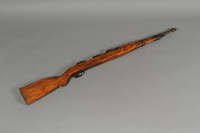
Mauser K98k bolt action rifle with a missing bolt used in eastern Poland
Object
Mauser K98k (Karabiner Kurz) bolt action rifle acquired ca. 2005 by Yahad-In Unum while researching atrocities committed by Nazi Germany on the Jewish people in the Ukraine. The K98k was a shorter and lighter modification of the Gewher 98, the standard German Army infantry rifle. It was manufactured in 1935 and used by the German Army until the end of the war in 1945. In early September 1939, Nazi Germany invaded Poland and a few weeks later, the Soviet Union occupied eastern Poland, now Ukraine, under the terms of the German-Soviet Pact. In late June 1941, Germany launched Operation Barbarossa, a surprise attack on Russia. The military assault was coordinated with killing squads whose goal was the Final Solution, the elimination of all Jews from the conquered territories. With the assistance of trained collaborators and local populace, the goal was achieved through deportations to killing centers and mass executions throughout the region. The lack of adequate rail transport meant that many villages had killing fields where the Jews were shot and buried in huge ditches, along with the bullets and other evidence. Through interviews with the remaining eyewitnesses, Yahad-In Unum locates and documents these remains of a Holocaust by bullets and offers respectful remembrance for the fallen.
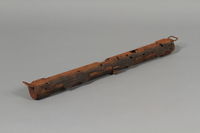
Spare machine gun barrel case with a missing locking clip recovered postwar at a mass execution site
Object
Spare barrel carrier for the MG 34 (Maschinengewehr 34) and the MG 42 excavated ca. 2005 by Yahad-In Unum from a mass execution and grave site in Ukraine uncovered by their research into atrocities committed by Nazi Germany against the Jewish population during WWII. It held and protected barrels that were replaced often to avoid overheating. The German Army issued the MG 34 in 1934. It was the primary infantry machine gun used in the war until it was replaced by the MG 42, which had similar features, but a higher rate of fire. In early September 1939, Nazi Germany invaded Poland and a few weeks later, the Soviet Union occupied eastern Poland, now Ukraine, under the terms of the German-Soviet Pact. In late June 1941, Germany launched Operation Barbarossa, a surprise attack on Russia. The military assault was coordinated with killing squads whose goal was the Final Solution, the elimination of all Jews from the conquered territories. With the assistance of trained collaborators and local populace, the goal was achieved through deportations to killing centers and mass executions throughout the region. The lack of adequate rail transport meant that many villages had killing fields where the Jews were shot and buried in huge ditches, along with the bullets and other evidence. Through interviews with the remaining eyewitnesses, Yahad-In Unum locates and documents these remains of a Holocaust by bullets and offers respectful remembrance for the fallen.
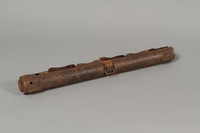
Spare machine gun barrel case recovered postwar at a mass execution site
Object
Spare barrel carrier for the MG 34 (Maschinengewehr 34) and the MG 42 excavated by Yahad-In Unum from a mass execution and grave site in Ukraine uncovered by their research into atrocities committed by Nazi Germany against the Jewish population during WWII. It held and protected barrels that were replaced often to avoid overheating. The German Army issued the MG 34 in 1934. It was the primary infantry machine gun used in the war until it was replaced by the MG 42, which had similar features, but a higher rate of fire. In early September 1939, Nazi Germany invaded Poland and a few weeks later, the Soviet Union occupied eastern Poland, now Ukraine, under the terms of the German-Soviet Pact. In late June 1941, Germany launched Operation Barbarossa, a surprise attack on Russia. The military assault was coordinated with killing squads whose goal was the Final Solution, the elimination of all Jews from the conquered territories. With the assistance of trained collaborators and local populace, the goal was achieved through deportations to killing centers and mass executions throughout the region. The lack of adequate rail transport meant that many villages had killing fields where the Jews were shot and buried in huge ditches, along with the bullets and other evidence. Through interviews with the remaining eyewitnesses, Yahad-In Unum locates and documents these remains of a Holocaust by bullets and offers respectful remembrance for the fallen.
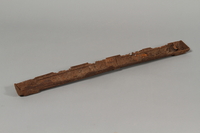
Base of a machine gun spare barrel case recovered postwar at a mass execution site
Object
Base of a spare barrel carrier for the MG 34 (Maschinengewehr 34) and the MG 42 excavated by Yahad-In Unum from a mass execution and grave site in Ukraine uncovered by their research into atrocities committed by Nazi Germany against the Jewish population during WWII. It held and protected barrels that were replaced often to avoid overheating. The German Army issued the MG 34 in 1934. It was the primary infantry machine gun used in the war until it was replaced by the MG 42, which had similar features, but a higher rate of fire. In early September 1939, Nazi Germany invaded Poland and a few weeks later, the Soviet Union occupied eastern Poland, now Ukraine, under the terms of the German-Soviet Pact. In late June 1941, Germany launched Operation Barbarossa, a surprise attack on Russia. The military assault was coordinated with killing squads whose goal was the Final Solution, the elimination of all Jews from the conquered territories. With the assistance of trained collaborators and local populace, the goal was achieved through deportations to killing centers and mass executions throughout the region. The lack of adequate rail transport meant that many villages had killing fields where the Jews were shot and buried in huge ditches, along with the bullets and other evidence. Through interviews with the remaining eyewitnesses, Yahad-In Unum locates and documents these remains of a Holocaust by bullets and offers respectful remembrance for the fallen.
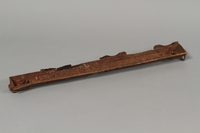
Lid of a machine gun spare barrel case recovered postwar at a mass execution site
Object
Lid of a spare barrel carrier for the MG 34 (Maschinengewehr 34) and the MG 42 excavated by Yahad-In Unum from a mass execution and grave site in Ukraine uncovered by their research into atrocities committed by Nazi Germany against the Jewish population during WWII. It held and protected barrels that were replaced often to avoid overheating. The German Army issued the MG 34 in 1934. It was the primary infantry machine gun used in the war until it was replaced by the MG 42, which had similar features, but a higher rate of fire. In early September 1939, Nazi Germany invaded Poland and a few weeks later, the Soviet Union occupied eastern Poland, now Ukraine, under the terms of the German-Soviet Pact. In late June 1941, Germany launched Operation Barbarossa, a surprise attack on Russia. The military assault was coordinated with killing squads whose goal was the Final Solution, the elimination of all Jews from the conquered territories. With the assistance of trained collaborators and local populace, the goal was achieved through deportations to killing centers and mass executions throughout the region. The lack of adequate rail transport meant that many villages had killing fields where the Jews were shot and buried in huge ditches, along with the bullets and other evidence. Through interviews with the remaining eyewitnesses, Yahad-In Unum locates and documents these remains of a Holocaust by bullets and offers respectful remembrance for the fallen.

MG42 machine gun barrel with a sealed breech recovered postwar at a mass execution site
Object
Machine gun barrel for the MG42 (Maschinengewehr 42) excavated ca. 2005 by Yahad-In Unum from a mass execution and grave site in Ukraine uncovered by their research into atrocities committed by Nazi Germany against the Jewish population during WWII. The barrel propels the bullets through the muzzle, and is replaced often to avoid overheating. The German Army issued the MG42 in 1942 as a replacement for the MG34, which had been the primary infantry machine gun used in the war. In September 1939, following Germany's invasion of Poland, areas of eastern Poland, now in Ukraine, were occupied by the Soviet Union pursuant to the terms of the German-Soviet Pact. In late June 1941, Germany launched Operation Barbarossa, a surprise attack on Russia. The military assault was coordinated with killing squads whose goal was the Final Solution, the elimination of all Jews from the conquered territories. With the assistance of trained collaborators and the local populace, the goal was achieved through deportations to killing centers and mass executions throughout the region. The lack of adequate rail transport meant that many villages had killing fields where the Jews were shot and buried in huge ditches, along with the bullets and other evidence. Through interviews with the remaining eyewitnesses, Yahad-In Unum locates and documents these remains of a Holocaust by bullets and offers respectful remembrance for the fallen.
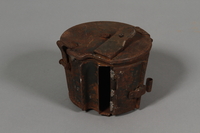
MG 34 and 42 round drum magazine recovered postwar at a mass execution site
Object
Bucket shaped drum magazine for the MG 34 (Maschinengewehr 34) and MG 42 excavated ca. 2005 by Yahad-In Unum from a mass execution and grave site in Ukraine uncovered by their research into atrocities committed by Nazi Germany against the Jewish population during WWII. It stores 50 to 70 rounds of ammunition in a spiral and feeds cartridges into the chamber. The German Army issued the MG 34 in 1934. It was the primary infantry machine gun used in the war, until it was replaced by the MG 42, which had similar features but a higher rate of fire. In September 1939, following Germany's invasion of Poland, areas of eastern Poland, now in Ukraine, were occupied by the Soviet Union pursuant to the terms of the German-Soviet Pact. In late June 1941, Germany launched Operation Barbarossa, a surprise attack on Russia. The military assault was coordinated with killing squads whose goal was the Final Solution, the elimination of all Jews from the conquered territories. With the assistance of trained collaborators and the local populace, the goal was achieved through deportations to killing centers and mass executions throughout the region. The lack of adequate rail transport meant that many villages had killing fields where the Jews were shot and buried in huge ditches, along with the bullets and other evidence. Through interviews with the remaining eyewitnesses, Yahad-In Unum locates and documents these remains of a Holocaust by bullets and offers respectful remembrance for the fallen.

Wide rectangular shovel head recovered postwar at a mass execution site
Object
Wide rectangular shovel blade excavated ca. 2005 by Yahad-In Unum from a mass execution and grave site in Ukraine, possibly Berdychiv or Khvativ, uncovered by their research into atrocities committed by Nazi Germany against the Jewish population during WWII. The German occupying forces often made civilians dig graves, transport Jews to killing sites, and fill in the graves after mass shootings. In September 1939, following Germany's invasion of Poland, areas of eastern Poland, now in Ukraine, were occupied by the Soviet Union pursuant to the terms of the German-Soviet Pact. In late June 1941, Germany launched Operation Barbarossa, a surprise attack on Russia. The military assault was coordinated with killing squads whose goal was the Final Solution, the elimination of all Jews from the conquered territories. With the assistance of trained collaborators and the local populace, the goal was achieved through deportations to killing centers and mass executions throughout the region. The lack of adequate rail transport meant that many villages had killing fields where the Jews were shot and buried in huge ditches, along with the bullets and other evidence. Through interviews with the remaining eyewitnesses, Yahad-In Unum locates and documents these remains of a Holocaust by bullets and offers respectful remembrance for the fallen.

Shovel head with a partial wooden handle recovered postwar at a mass execution and grave site in Ukraine
Object
Shovel head excavated ca. 2005 by Yahad-In Unum in either Berdychiv or Khvativ, Ukraine, from a mass execution and grave site uncovered by their research into atrocities committed by Nazi Germany against the Jewish population during WWII. The German occupying forces often made civilians dig graves, transport Jews to killing sites, and fill in the graves after mass shootings. In September 1939, following Germany's invasion of Poland, areas of eastern Poland, now in Ukraine, were occupied by the Soviet Union pursuant to the terms of the German-Soviet Pact. In late June 1941, Germany launched Operation Barbarossa, a surprise attack on Russia. The military assault was coordinated with killing squads whose goal was the Final Solution, the elimination of all Jews from the conquered territories. With the assistance of trained collaborators and the local populace, the goal was achieved through deportations to killing centers and mass executions throughout the region. The lack of adequate rail transport meant that many villages had killing fields where the Jews were shot and buried in huge ditches, along with the bullets and other evidence. Through interviews with the remaining eyewitnesses, Yahad-In Unum locates and documents these remains of a Holocaust by bullets and offers respectful remembrance for the fallen.
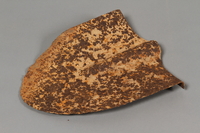
Shield shaped shovel head recovered postwar at a mass execution site
Object
Shield shaped shovel blade excavated ca. 2005 by Yahad-In Unum from a mass execution and grave site in Ukraine, possibly Berdychiv or Khvativ, uncovered by their research into atrocities committed by Nazi Germany against the Jewish population during WWII. The German occupying forces often made civilians dig graves, transport Jews to killing sites, and fill in the graves after mass shootings. In September 1939, following Germany's invasion of Poland, areas of eastern Poland, now in Ukraine, were occupied by the Soviet Union pursuant to the terms of the German-Soviet Pact. In late June 1941, Germany launched Operation Barbarossa, a surprise attack on Russia. The military assault was coordinated with killing squads whose goal was the Final Solution, the elimination of all Jews from the conquered territories. With the assistance of trained collaborators and the local populace, the goal was achieved through deportations to killing centers and mass executions throughout the region. The lack of adequate rail transport meant that many villages had killing fields where the Jews were shot and buried in huge ditches, along with the bullets and other evidence. Through interviews with the remaining eyewitnesses, Yahad-In Unum locates and documents these remains of a Holocaust by bullets and offers respectful remembrance for the fallen.
230 discharged bullets and 250 discharged German manufactured bullet casings found at a mass execution site
Object
230 discharged bullets and 250 discharged bullet casings, with a contemporary archeological bag and a plastic bag used to transport them, recovered in 2005 by Yahad-In Unum at a mass execution site in Khvativ, a small village in the Lvivska province of Ukraine. A casing contains propellant and primer, and holds the bullet in place. One casing has a headstamp marking the German manufacturer, location, year, batch, and material. In September 1939, following Germany's invasion of Poland, the Lvivska province was occupied by the Soviet Union pursuant to the terms of the German-Soviet Pact. In late June 1941, Germany launched Operation Barbarossa, a surprise attack on Russia. The military assault was coordinated with killing squads whose goal was the Final Solution, the elimination of all Jews from the conquered territories. With the assistance of trained collaborators and the local populace, the goal was achieved through deportations to killing centers and mass executions throughout the region. The lack of adequate rail transport meant that many villages had killing fields where the Jews were shot and buried in huge ditches, along with the bullets and other evidence. Through interviews with the remaining eyewitnesses, Yahad-In Unum locates and documents these remains of a Holocaust by bullets and offers respectful remembrance for the fallen.
84 discharged bullets and 1 casing found at a mass execution site
Object
84 discharged bullets and one casing, with the contemporary archeological bag used for transport, recovered in 2005 by Yahad-In Unum at a mass execution site in Khvativ, a small village in the Lvivska province of Ukraine. A casing contains propellant and primer, and holds the bullet in place. Several of the casings have a headstamp marking the German manufacturer, location, year, batch, and material. In September 1939, following Germany's invasion of Poland, the Lvivska province was occupied by the Soviet Union pursuant to the terms of the German-Soviet Pact. In late June 1941, Germany launched Operation Barbarossa, a surprise attack on Russia. The military assault was coordinated with killing squads whose goal was the Final Solution, the elimination of all Jews from the conquered territories. With the assistance of trained collaborators and the local populace, the goal was achieved through deportations to killing centers and mass executions throughout the region. The lack of adequate rail transport meant that many villages had killing fields where the Jews were shot and buried in huge ditches, along with the bullets and other evidence. Through interviews with the remaining eyewitnesses, Yahad-In Unum locates and documents these remains of a Holocaust by bullets and offers respectful remembrance for the fallen.
9 discharged bullets and 12 discharged bullet casings recovered postwar at a mass execution site
Object
9 discharged bullets and 12 discharged bullet casings recovered by Yahad-In Unum in 2005-2006 while excavating mass execution and grave sites in Ukraine uncovered by their research into the atrocities committed by Nazi Germany against the Jewish population. A casing contains propellant and primer, and holds the bullet in place. One casing has a headstamp marking a Czechoslovakian manufacturer, location, and date. In September 1939, following Germany's invasion of Poland, areas of eastern Poland, now in Ukraine, were occupied by the Soviet Union pursuant to the terms of the German-Soviet Pact. In late June 1941, Germany launched Operation Barbarossa, a surprise attack on Russia. The military assault was coordinated with killing squads whose goal was the Final Solution, the elimination of all Jews from the conquered territories. With the assistance of trained collaborators and the local populace, the goal was achieved through deportations to killing centers and mass executions throughout the region. The lack of adequate rail transport meant that many villages had killing fields where the Jews were shot and buried in huge ditches, along with the bullets and other evidence. Through interviews with the remaining eyewitnesses, Yahad-In Unum locates and documents these remains of a Holocaust by bullets and offers respectful remembrance for the fallen.
Partial black plastic widetooth comb discarded at a mass execution site
Object
Partial black plastic comb found ca. 2005 by Yahad-In Unum while excavating mass execution and grave sites in Ukraine uncovered by their research into the atrocities committed by Nazi Germany against the Jewish population. In September 1939, following Germany's invasion of Poland, areas of eastern Poland, now in Ukraine, were occupied by the Soviet Union pursuant to the terms of the German-Soviet Pact. In late June 1941, Germany launched Operation Barbarossa, a surprise attack on Russia. The military assault was coordinated with killing squads whose goal was the Final Solution, the elimination of all Jews from the conquered territories. With the assistance of trained collaborators and the local populace, the goal was achieved through deportations to killing centers and mass executions throughout the region. The lack of adequate rail transport meant that many villages had killing fields where the Jews were shot and buried in huge ditches, along with the bullets and other evidence. Through interviews with the remaining eyewitnesses, Yahad-In Unum locates and documents these remains of a Holocaust by bullets and offers respectful remembrance for the fallen.
Wooden ammunition box with German paper labels recovered in the Ukraine
Object
Wooden ammunition box acquired ca. 2005 by Yahad-In Unum from a mass execution and grave site in Ukraine uncovered by their research into atrocities committed by Nazi Germany against the Jewish population during WWII. In September 1939, following Germany's invasion of Poland, areas of eastern Poland, now in Ukraine, were occupied by the Soviet Union pursuant to the terms of the German-Soviet Pact. In late June 1941, Germany launched Operation Barbarossa, a surprise attack on Russia. The military assault was coordinated with killing squads whose goal was the Final Solution, the elimination of all Jews from the conquered territories. With the assistance of trained collaborators and the local populace, the goal was achieved through deportations to killing centers and mass executions throughout the region. The lack of adequate rail transport meant that many villages had killing fields where the Jews were shot and buried in huge ditches, along with the bullets and other evidence. Through interviews with the remaining eyewitnesses, Yahad-In Unum locates and documents these remains of a Holocaust by bullets and offers respectful remembrance for the fallen.
Wooden ammunition box with German paper labels recovered in the Ukraine
Object
Wooden ammunition box acquired ca. 2005 by Yahad-In Unum from a mass execution and grave site in Ukraine uncovered by their research into atrocities committed by Nazi Germany against the Jewish population during WWII. In September 1939, following Germany's invasion of Poland, areas of eastern Poland, now in Ukraine, were occupied by the Soviet Union pursuant to the terms of the German-Soviet Pact. In late June 1941, Germany launched Operation Barbarossa, a surprise attack on Russia. The military assault was coordinated with killing squads whose goal was the Final Solution, the elimination of all Jews from the conquered territories. With the assistance of trained collaborators and the local populace, the goal was achieved through deportations to killing centers and mass executions throughout the region. The lack of adequate rail transport meant that many villages had killing fields where the Jews were shot and buried in huge ditches, along with the bullets and other evidence. Through interviews with the remaining eyewitnesses, Yahad-In Unum locates and documents these remains of a Holocaust by bullets and offers respectful remembrance for the fallen.
Wooden ammunition box with German paper labels recovered in the Ukraine
Object
Wooden ammunition box acquired ca. 2005 by Yahad-In Unum from a mass execution and grave site in Ukraine uncovered by their research into atrocities committed by Nazi Germany against the Jewish population during WWII. In September 1939, following Germany's invasion of Poland, areas of eastern Poland, now in Ukraine, were occupied by the Soviet Union pursuant to the terms of the German-Soviet Pact. In late June 1941, Germany launched Operation Barbarossa, a surprise attack on Russia. The military assault was coordinated with killing squads whose goal was the Final Solution, the elimination of all Jews from the conquered territories. With the assistance of trained collaborators and the local populace, the goal was achieved through deportations to killing centers and mass executions throughout the region. The lack of adequate rail transport meant that many villages had killing fields where the Jews were shot and buried in huge ditches, along with the bullets and other evidence. Through interviews with the remaining eyewitnesses, Yahad-In Unum locates and documents these remains of a Holocaust by bullets and offers respectful remembrance for the fallen.



